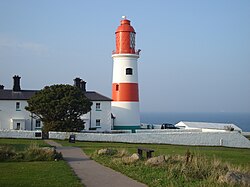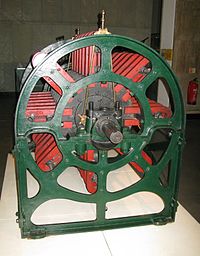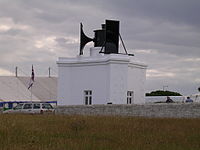Souter Lighthouse: Difference between revisions
Created page with 'right|thumb|250px|Souter Lighthouse {{county|Durham}} '''Souter Lighthouse''' ({{map|NZ408642}}) is a lighthouse in the …' |
|||
| Line 62: | Line 62: | ||
{{Reflist|colwidth=35em}} | {{Reflist|colwidth=35em}} | ||
[[Category:Lighthouses in County Durham]] | |||
[[Category:National Trust properties in County Durham]] | [[Category:National Trust properties in County Durham]] | ||
Revision as of 22:06, 29 January 2024

Souter Lighthouse (NZ408642) is a lighthouse in the North Sea off the village of Marsden in County Durham. Souter was the first lighthouse in the world to be actually designed and built specifically to use alternating electric current, the most advanced lighthouse technology of its day.
The lighthouse was a much needed aid to navigation due to the number of wrecks on the dangerous reefs of Whitburn Steel[1] which lay directly under the water in the surrounding area. In one year alone - 1860 - there were 20 shipwrecks. This contributed to making this coastline the most dangerous in the country, with an average of around 44 shipwrecks per every mile of coastline.
The lighthouse is located on Lizard Point, but takes its name from Souter Point, which is located a mile to the south. This was the intended site for the lighthouse, but it was felt that Lizard Point offered better visibility, as the cliffs there are higher, so the lighthouse was built there instead. The Souter Lighthouse name was retained in order to avoid confusion with the then recently built Lizard Lighthouse on Lizard Point in Cornwall.
The lighthouse was decommissioned in 1988, but continued to serve as a radio navigation beacon up until 1999 when it was finally closed.
As Souter was never automated, it remains much in its original operational state except for updates during it lifespan to its lantern and electrical apparatus.
Today the decommissioned lighthouse is owned by the National Trust and open to the public; the engine room, light tower and keeper's living quarters are all on view. There is also an outdoor play area, Trusty Club and indoor activities to accommodate young visitors. Two of the former lighthouse keepers' cottages are used as National Trust holiday cottages.
Construction
Designed by James Douglass it was opened in 1871, with construction supervised by Henry Norris.[2] The contract for building the lighthouse and keeper's cottage was reported in March 1869 as being £8,000[3] and was awarded to the local firm of James Todd,[4] after complaints that local builders had not had the opportunity to reply to tender as it had not been advertised locally.[5] The foundation stone was ceremonially laid by Admiral Collinson's sister on 9 June 1869.[6]
Electricity

Trinity House had carried out an extensive testing and selection process over five years and included comparison with oil lights and examination of equipment in Britain and France.[7]
The 800,000 candle power light was generated using carbon arcs and not an incandescent light bulb, and could be seen for up to 26 miles. Carbon arc lights for lighthouses were pioneered by Professor Frederick Hales Holmes (c 1840-1875) with experiments in 1857 at Blackwell and South Foreland off the Kent coast and a test installation at Dungeness in 1862 and complete installation at Souter in 1870.[8] Electricity was provided by Holmes' own magneto electric generators for which he took out a series of patents[9] during those years. One of the Holmes generators built in 1867 and used at Souter is now on display at the Science Museum, London.[10]
The generators were driven using not a steam engine but three so-called furnace gas engines made by the Felix Brown company of New York City. Located in the engine-house, each Brown was driving a pair of generators and an air-pump to feed the pressure tank of a foghorn.
Foghorn

The foghorn has seen many changes over the years. When the lighthouse was first built, a single horn of a clay and iron pipe design, facing straight out to sea, was provided. This was replaced in 1873 by a pair of twin horns to the same design, angled to spread the noise up and down the coast. In turn these were superseded by twin Rayleigh trumpets in the 1920s, with the foghorn house remodelled at the seaward corners to accommodate them, then in 1953 these gave way to the present diaphone fog horns.
The horns produced a five-second blast every 30 seconds in poor weather up until 1988, when Souter Lighthouse was decommissioned by Trinity House. The siren signal was a 5-second sound of 480 Hz every 5 minutes.
The foghorns remain in working order and are sounded on special occasions throughout the year, most notably during the monthly Engine Room Day, which is held at the lighthouse during the summer months.
Outside links
- Souter Lighthouse and the Leas information at the National Trust
- National Trust Collections - Highlights from Souter Lighthouse, Tyne & Wear (Accredited Museum)
- Map of Souter Lighthouse
References
- ↑ "Newcastle Courant". 18 June 1869. pp. 6. "a new lighthouse to be erected on Souter Point...It will erected to prevent wrecks from occurring, if possible, on Whitburn Steel, of which there have been so many complaints within recent years."
- ↑ "Shields Gazette and Daily Telegraph". 9 September 1870. pp. 3. "the works are being pushed rapidly forward under the supervision of Mr H. Norris, the board and resident engineer"
- ↑ "Sheffield Daily Telegraph". 11 March 1869. pp. 2. "A new lighthouse and keepers' residence are to erected at Souter Point near, South Shields. The contract for building has been let for £8,000."
- ↑ The Architect and Contract Reporter: A Weekly Illustrated Journal. 1. January to June 1869. p. 183. "The contract for the erection of a new lighthouse and lighthouse-keepers residence at Souter Point, near Sunderland, has been let to Mr. Todd, builder, of South Shields, for £8,000".
- ↑ "Shields Gazette and Daily Telegraph". 12 April 1869. pp. 2. "Some months ago, tenders were advertised for in the Sunderland papers, asking offers for the erection of a lighthouse on Souter Point. Most of the people in Shields hardly ever saw a Sunderland paper in their lives, yet the Shields builders were virtually shut out from competing for a lighthouse within the limits of their own Poor-Law Union, so far as publicity of the fact of tenders being wanted was concerned. Communications were accordingly made from this office on the subject; the advertisement appeared in the Gazette, and a South Shields contractor ultimately got the job."
- ↑ "Shields Gazette and Daily Telegraph". 9 June 1869. pp. 9. "The foundation-stone of the lighthouse at Souter Point was laid yesterday afternoon by Mrs Blain (sister to Admiral Collinson) in the presence of the committee of the Elder Brethren of the Trinity House, London, Admiral Collinson, Captain Nesbitt, Captain Webb, Mr G. N. Douglas[sic], engineer to the Corporation, and friends. Robert [sic] Norris is the superintendent of the works, and Mr James Todd is the contractor."
- ↑ "Dover Express". 22 May 1868. pp. 4.
- ↑ Electricity Supply in the United Kingdom - A Chronology from the beginnings of the Industry to 31 December 1985 (4th ed.). The Electricity Council. 1987 [1973]. p. 15. ISBN 0-85188-105-X.
- ↑ Biographical Dictionary of the History of Technology. Routledge. 1996. p. 606. ISBN 0-415-06042-7.
- ↑ "Holmes's electricity generator, 1867". http://www.sciencemuseum.org.uk/objects/electricity_supply/1915-295.aspx. Retrieved 4 November 2013.